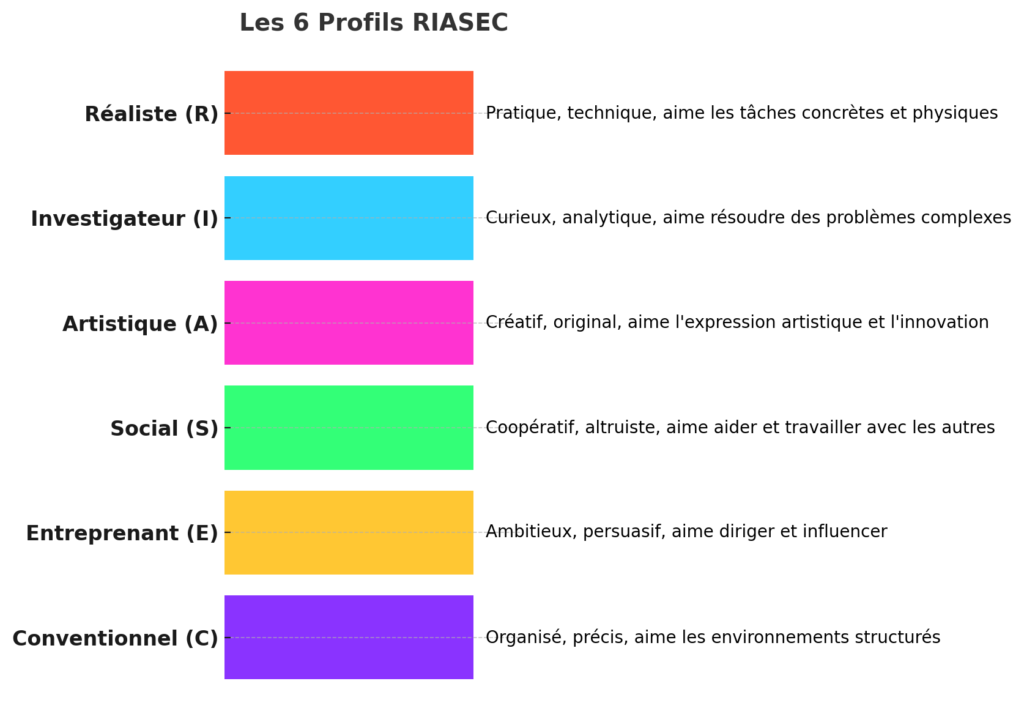The arrival of artificial intelligence (AI) is shaking up the job market at an impressive pace. Automation of tasks, changing professions, new skills in demand: these transformations are leading many professionals to ask themselves a crucial question: How do you reorient your career to stay relevant in this new environment? This is where the RIASEC model, integrated into JobVision, becomes a strategic ally.
Understanding the RIASEC model
Created by John Holland, the RIASEC model is based on six main typologies that describe career appetites and interests:
1. Realist (R): People who enjoy practical, manual or technical activities.
2. Investigator (I): Profiles attracted by analysis, research and solving complex problems.
3. Artistic (A): Those who value creativity, self-expression and innovation.
4. Social (S): Individuals motivated by mutual aid, collaboration and human relations.
5. Entrepreneurial (E): Those who take pleasure in leading, influencing and motivating, whether or not they set up their own business.
6. Conventional (C): Profiles that prefer structured environments and methodical tasks.
This model helps individuals better understand their career preferences and identify the work environments that match them.
JobVision: towards an informed career path
JobVision uses the RIASEC model to guide individuals in their career orientation or reorientation. Through a comprehensive assessment of their interests, values and skills, this tool creates a clear link between personal characteristics and suitable careers.
In the context of AI, JobVision offers a unique perspective:
- Identifying enduring strengths: soft skills competencies (creativity, empathy, critical thinking) remain essential in the face of AI. JobVision helps to highlight these often underestimated strengths.
- Highlighting emerging sectors: Drawing on the results of the RIASEC model, JobVision can point to sectors where AI is creating new opportunities, such as data analysis, technology project management, or human support in automated fields.
- Aligning passions and skills: Professions evolve, but your core interests remain a reliable compass for navigating this change.
Concrete examples of career reorientation with JobVision
To better illustrate the power of the RIASEC model and JobVision, here are some examples of transitions adapted to various profiles:
1. Realistic Profile (R)
- Before : An industrial technician working on conventional machines.
- With AI: A specialization in automated systems maintenance or remote diagnostics using AI tools.
- Other paths: Become a drone operator or robotics specialist for agricultural or industrial applications.
2. Investigator (I) profile
- Previously: A research scientist.
- With AI: Using AI to analyze massive data in genetics, climatology or economics.
- Other paths: Reorientation towards data science or predictive analytics.
3. Artistic profile (A)
- Before : A graphic designer or content creator.
- With AI: Collaboration with AI tools to create designs or manage interactive advertising campaigns.
- Other avenues: Development of immersive virtual or augmented reality experiences.
4. Social Profile (S)
- Before : A teacher in a traditional setting.
- With AI: Design of online training courses tailored to individual needs or mentoring role to support technological transitions.
- Other tracks: Coaching or consulting in digital transformation for teams.
5. Entrepreneurial profile (E)
- Previously: A sales manager.
- With AI: Analysis of customer behavior using predictive tools to optimize sales.
- Other leads: Development of data-driven sales strategies and automated marketing.
6. Conventional profile (C)
- Previously: An accountant.
- With AI: Oversight of automated accounting tools and strategic financial analysis.
- Other leads: Automated systems audit or regulatory compliance roles.
Why the RIASEC model is particularly relevant to AI
AI tends to automate routine or repetitive tasks, but it does not replace the human qualities that differentiate individuals. By identifying their natural inclinations with RIASEC, a person can:
- Explore careers that exploit their unique strengths: for example, an artistic profile might find its place in user interface design, while a social profile might thrive in roles related to customer experience or collaborative team development.
- Develop targeted adaptability: Understanding your strengths enables you to focus on acquiring relevant technical or digital skills without losing sight of your core preferences.
- Searching for human roles in an automated world: AI does not replace the emotional and relational dimension of jobs. RIASEC highlights activities that value these dimensions.
Conclusion: a compass for navigating change
Career reorientation in the age of AI is not a matter of survival, but of opportunity. The RIASEC model, combined with JobVision, offers a structured and personalized approach to this challenge. It helps turn uncertainty into a concrete plan, centered on your strengths and passions.
By better understanding your preferences and identifying areas where they can shine, you’re ready to embrace the future with confidence. AI shouldn’t be seen as an obstacle, but as a lever to reinvent your career around what makes you unique.
#CareerReorientation #ArtificialIntelligence #SoftSkills #JobVision #VersusTalentProfile #RIASEC


